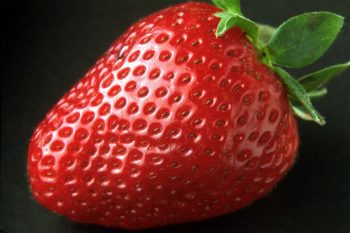 TASTY AND HEALTHY CANCER FIGHTING FRUITS
TASTY AND HEALTHY CANCER FIGHTING FRUITS
Hi everyone! It’s Spring – it’s April – it’s NATIONAL CANCER CONTROL MONTH – and it’s another WHAT’S ON THE #MENU MONDAY.
So, it’s the perfect time to profile 5 GREAT CANCER FIGHTING FRUITS that are in season RIGHT NOW!
Of course, I’m sure you’re familiar with all of these wonderful fruits, because they’re tasty and easily found in your neighborhood market. But, do you really know just how good they can be for you? Let’s find out now!
5 FANTASTIC CANCER-FIGHTING SPRING FRUITS:
- STRAWBERRY. Boy, this fruit always makes our “go-to” list of healthy foods – and with good reason. Strawberries are packed with vitamin C and vitamin C is an incredible antioxidant that helps prevent cancer by boosting our immune system – and, of course, a strong immune system is our best defense against cancer. Strawberries also contain a phytochemical called ellagic acid, which is known to suppress cancer cell growth. And, these beautiful berries also contain lutein and zeathancin – two more powerful antioxidants that destroy and neutralize the negative effect of free radicals on our cells. In addition to fighting cancer, strawberries also fight bad cholesterol, promote eye health and help regulate blood pressure. The peak season for strawberry harvesting is April through June – so pick up a basket or two today!
 GRAPEFRUIT. Here we have another powerhouse fruit that’s loaded with vitamin C, an important ally in the body’s fight against free radicals and oxidative stress. Grapefruit juice helps impede an enzyme linked to the development of lung cancer and it encourages the suicide – or apoptosis – of cancer cells related to colon cancer. Grapefruit contains a substance called naringenin, which helps protect against prostate cancer and repair damaged DNA in prostate cells. The red color of grapefruit comes from another cancer-fighting antioxidant called carotenoid. And, the phytonutrients called limonoids help prevent cancers of the mouth, skin, lung and stomach by helping the liver to expel more toxins. Moreover, the pulp of the grapefruit is loaded with the phytochemical glucarates, which offers protection from breast cancer. Add to that the fact that this fruit also promotes health of the skin, kidneys and circulatory system – and we have a winner! Grapefruit will remain in season through June – so be sure to add this to your favorite fruit salad.
GRAPEFRUIT. Here we have another powerhouse fruit that’s loaded with vitamin C, an important ally in the body’s fight against free radicals and oxidative stress. Grapefruit juice helps impede an enzyme linked to the development of lung cancer and it encourages the suicide – or apoptosis – of cancer cells related to colon cancer. Grapefruit contains a substance called naringenin, which helps protect against prostate cancer and repair damaged DNA in prostate cells. The red color of grapefruit comes from another cancer-fighting antioxidant called carotenoid. And, the phytonutrients called limonoids help prevent cancers of the mouth, skin, lung and stomach by helping the liver to expel more toxins. Moreover, the pulp of the grapefruit is loaded with the phytochemical glucarates, which offers protection from breast cancer. Add to that the fact that this fruit also promotes health of the skin, kidneys and circulatory system – and we have a winner! Grapefruit will remain in season through June – so be sure to add this to your favorite fruit salad. BLOOD ORANGE. A close relative of the navel orange, this orange is available all spring long from January through June. As with our other citrus fruits, this orange is a great source of vitamin C – our old cancer-fighting friend and antioxidant. Two blood oranges supply our entire day with the recommended daily dose of vitamin C – boosting our immune system, fighting infection and suppressing free radicals. This vitamin C is thought to reduce our risk of cervical, oral, stomach and rectal cancers. The red color of this orange comes from anthocyanins, a natural compound with anti-inflammatory properties, which inhibits the growth of cancer cells. This compound also induces cancer cell suicide – apoptosis – and protects the DNA of our cells from carcinogens and environmental toxins. After all, the blood orange is grown in the volcanic atmosphere of Mount Etna in Sicily. This is what gives this orange its high levels of antioxidants, which are just not found in other varieties of orange.
BLOOD ORANGE. A close relative of the navel orange, this orange is available all spring long from January through June. As with our other citrus fruits, this orange is a great source of vitamin C – our old cancer-fighting friend and antioxidant. Two blood oranges supply our entire day with the recommended daily dose of vitamin C – boosting our immune system, fighting infection and suppressing free radicals. This vitamin C is thought to reduce our risk of cervical, oral, stomach and rectal cancers. The red color of this orange comes from anthocyanins, a natural compound with anti-inflammatory properties, which inhibits the growth of cancer cells. This compound also induces cancer cell suicide – apoptosis – and protects the DNA of our cells from carcinogens and environmental toxins. After all, the blood orange is grown in the volcanic atmosphere of Mount Etna in Sicily. This is what gives this orange its high levels of antioxidants, which are just not found in other varieties of orange. APRICOT. It may not be citrus, but the apricot is still packed with cancer-fighting antioxidants. This stone fruit is rich in vitamin A, which protects our immune system and helps fight invading diseases like cancer. The orange color of the apricot is caused by the carotenoids or beta-carotene, which also acts as an antioxidant protecting body cells from free radical damage. And, of course, the apricot contains large amounts of vitamin C – our number one antioxidant that inhibits cellular oxidative stress from free radicals. By inhibiting oxidative stress or “cellular rust,” vitamin C also helps protect against lung, mouth, throat, colon and esophageal cancer and helps regenerate our supply of another important antioxidant, vitamin E. Finally, the seeds of the apricot contain laetrile – also known as B17 – a substance many believe to be an effective cancer-fighting substance. B17, however, also contains the poison cyanide. Because of this, laetrile was banned by the FDA in 1971. Clearly, more research is needed and anyone contemplating the use of apricot seeds to protect from or treat cancer should consult with her or his physician. Until then, enjoy this luscious fruit – sans seeds – which is available and at its peak from May into July.
APRICOT. It may not be citrus, but the apricot is still packed with cancer-fighting antioxidants. This stone fruit is rich in vitamin A, which protects our immune system and helps fight invading diseases like cancer. The orange color of the apricot is caused by the carotenoids or beta-carotene, which also acts as an antioxidant protecting body cells from free radical damage. And, of course, the apricot contains large amounts of vitamin C – our number one antioxidant that inhibits cellular oxidative stress from free radicals. By inhibiting oxidative stress or “cellular rust,” vitamin C also helps protect against lung, mouth, throat, colon and esophageal cancer and helps regenerate our supply of another important antioxidant, vitamin E. Finally, the seeds of the apricot contain laetrile – also known as B17 – a substance many believe to be an effective cancer-fighting substance. B17, however, also contains the poison cyanide. Because of this, laetrile was banned by the FDA in 1971. Clearly, more research is needed and anyone contemplating the use of apricot seeds to protect from or treat cancer should consult with her or his physician. Until then, enjoy this luscious fruit – sans seeds – which is available and at its peak from May into July. FIG. Okay – so if you’re someone who only knows a fig because you enjoy an occasional Fig Newton cookie, it’s time to broaden your horizons. The fig historically has been known to be a medicinal food – and an effective fighter of cancer. First, the fig is rich in antioxidants that prevent cellular DNA damage due to free radicals. Studies show that eating just two medium figs results in a significant increase in antioxidant activity in the body. Figs contain specific anti-cancer properties and nine bioactive compounds proven to be toxic to melanoma, breast, throat, bone, brain, stomach and liver cancers in several studies. Moreover, figs are loaded with insoluble fiber, which protects against colon cancer by inhibiting the growth of harmful bacteria and moving toxic wastes through the intestinal tract more efficiently and quickly. Fiber also helps eliminate free radicals from the intestinal tract and protects from hormonal imbalance and breast cancer in post-menopausal women. The first harvest of figs – known as the Breba harvest – is now in full swing and will last for several more weeks. So, be adventurous – buy some figs!
FIG. Okay – so if you’re someone who only knows a fig because you enjoy an occasional Fig Newton cookie, it’s time to broaden your horizons. The fig historically has been known to be a medicinal food – and an effective fighter of cancer. First, the fig is rich in antioxidants that prevent cellular DNA damage due to free radicals. Studies show that eating just two medium figs results in a significant increase in antioxidant activity in the body. Figs contain specific anti-cancer properties and nine bioactive compounds proven to be toxic to melanoma, breast, throat, bone, brain, stomach and liver cancers in several studies. Moreover, figs are loaded with insoluble fiber, which protects against colon cancer by inhibiting the growth of harmful bacteria and moving toxic wastes through the intestinal tract more efficiently and quickly. Fiber also helps eliminate free radicals from the intestinal tract and protects from hormonal imbalance and breast cancer in post-menopausal women. The first harvest of figs – known as the Breba harvest – is now in full swing and will last for several more weeks. So, be adventurous – buy some figs!
In closing, thanks again for joining me everyone. It’s great to Celebrate Spring with Five Fantastic Fruits and National Cancer Control Month. Fighting cancer by eating Great Food? Now, that’s a Great Idea!
Until next time, stay in GOOD HEALTH and . . .
TAKE THE COURSE AND TAKE CHARGE!
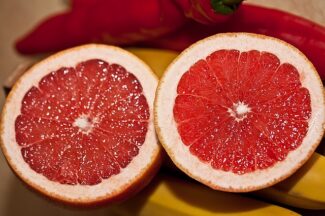 GRAPEFRUIT. Here we have another powerhouse fruit that’s loaded with vitamin C, an important ally in the body’s fight against free radicals and oxidative stress. Grapefruit juice helps impede an enzyme linked to the development of lung cancer and it encourages the suicide – or apoptosis – of cancer cells related to colon cancer. Grapefruit contains a substance called naringenin, which helps protect against prostate cancer and repair damaged DNA in prostate cells. The red color of grapefruit comes from another cancer-fighting antioxidant called carotenoid. And, the phytonutrients called limonoids help prevent cancers of the mouth, skin, lung and stomach by helping the liver to expel more toxins. Moreover, the pulp of the grapefruit is loaded with the phytochemical glucarates, which offers protection from breast cancer. Add to that the fact that this fruit also promotes health of the skin, kidneys and circulatory system – and we have a winner! Grapefruit will remain in season through June – so be sure to add this to your favorite fruit salad.
GRAPEFRUIT. Here we have another powerhouse fruit that’s loaded with vitamin C, an important ally in the body’s fight against free radicals and oxidative stress. Grapefruit juice helps impede an enzyme linked to the development of lung cancer and it encourages the suicide – or apoptosis – of cancer cells related to colon cancer. Grapefruit contains a substance called naringenin, which helps protect against prostate cancer and repair damaged DNA in prostate cells. The red color of grapefruit comes from another cancer-fighting antioxidant called carotenoid. And, the phytonutrients called limonoids help prevent cancers of the mouth, skin, lung and stomach by helping the liver to expel more toxins. Moreover, the pulp of the grapefruit is loaded with the phytochemical glucarates, which offers protection from breast cancer. Add to that the fact that this fruit also promotes health of the skin, kidneys and circulatory system – and we have a winner! Grapefruit will remain in season through June – so be sure to add this to your favorite fruit salad.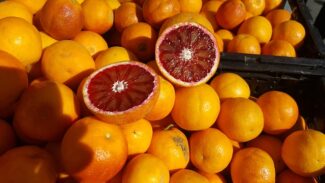 BLOOD ORANGE. A close relative of the navel orange, this orange is available all spring long from January through June. As with our other citrus fruits, this orange is a great source of vitamin C – our old cancer-fighting friend and antioxidant. Two blood oranges supply our entire day with the recommended daily dose of vitamin C – boosting our immune system, fighting infection and suppressing free radicals. This vitamin C is thought to reduce our risk of cervical, oral, stomach and rectal cancers. The red color of this orange comes from anthocyanins, a natural compound with anti-inflammatory properties, which inhibits the growth of cancer cells. This compound also induces cancer cell suicide – apoptosis – and protects the DNA of our cells from carcinogens and environmental toxins. After all, the blood orange is grown in the volcanic atmosphere of Mount Etna in Sicily. This is what gives this orange its high levels of antioxidants, which are just not found in other varieties of orange.
BLOOD ORANGE. A close relative of the navel orange, this orange is available all spring long from January through June. As with our other citrus fruits, this orange is a great source of vitamin C – our old cancer-fighting friend and antioxidant. Two blood oranges supply our entire day with the recommended daily dose of vitamin C – boosting our immune system, fighting infection and suppressing free radicals. This vitamin C is thought to reduce our risk of cervical, oral, stomach and rectal cancers. The red color of this orange comes from anthocyanins, a natural compound with anti-inflammatory properties, which inhibits the growth of cancer cells. This compound also induces cancer cell suicide – apoptosis – and protects the DNA of our cells from carcinogens and environmental toxins. After all, the blood orange is grown in the volcanic atmosphere of Mount Etna in Sicily. This is what gives this orange its high levels of antioxidants, which are just not found in other varieties of orange.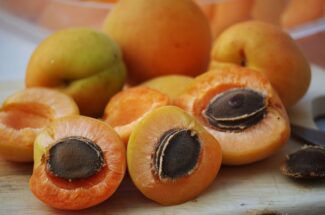 APRICOT. It may not be citrus, but the apricot is still packed with cancer-fighting antioxidants. This stone fruit is rich in vitamin A, which protects our immune system and helps fight invading diseases like cancer. The orange color of the apricot is caused by the carotenoids or beta-carotene, which also acts as an antioxidant protecting body cells from free radical damage. And, of course, the apricot contains large amounts of vitamin C – our number one antioxidant that inhibits cellular oxidative stress from free radicals. By inhibiting oxidative stress or “cellular rust,” vitamin C also helps protect against lung, mouth, throat, colon and esophageal cancer and helps regenerate our supply of another important antioxidant, vitamin E. Finally, the seeds of the apricot contain laetrile – also known as B17 – a substance many believe to be an effective cancer-fighting substance. B17, however, also contains the poison cyanide. Because of this, laetrile was banned by the FDA in 1971. Clearly, more research is needed and anyone contemplating the use of apricot seeds to protect from or treat cancer should consult with her or his physician. Until then, enjoy this luscious fruit – sans seeds – which is available and at its peak from May into July.
APRICOT. It may not be citrus, but the apricot is still packed with cancer-fighting antioxidants. This stone fruit is rich in vitamin A, which protects our immune system and helps fight invading diseases like cancer. The orange color of the apricot is caused by the carotenoids or beta-carotene, which also acts as an antioxidant protecting body cells from free radical damage. And, of course, the apricot contains large amounts of vitamin C – our number one antioxidant that inhibits cellular oxidative stress from free radicals. By inhibiting oxidative stress or “cellular rust,” vitamin C also helps protect against lung, mouth, throat, colon and esophageal cancer and helps regenerate our supply of another important antioxidant, vitamin E. Finally, the seeds of the apricot contain laetrile – also known as B17 – a substance many believe to be an effective cancer-fighting substance. B17, however, also contains the poison cyanide. Because of this, laetrile was banned by the FDA in 1971. Clearly, more research is needed and anyone contemplating the use of apricot seeds to protect from or treat cancer should consult with her or his physician. Until then, enjoy this luscious fruit – sans seeds – which is available and at its peak from May into July.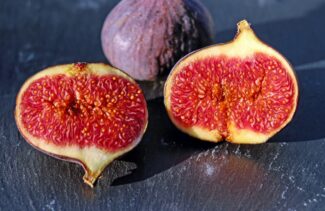 FIG. Okay – so if you’re someone who only knows a fig because you enjoy an occasional Fig Newton cookie, it’s time to broaden your horizons. The fig historically has been known to be a medicinal food – and an effective fighter of cancer. First, the fig is rich in antioxidants that prevent cellular DNA damage due to free radicals. Studies show that eating just two medium figs results in a significant increase in antioxidant activity in the body. Figs contain specific anti-cancer properties and nine bioactive compounds proven to be toxic to melanoma, breast, throat, bone, brain, stomach and liver cancers in several studies. Moreover, figs are loaded with insoluble fiber, which protects against colon cancer by inhibiting the growth of harmful bacteria and moving toxic wastes through the intestinal tract more efficiently and quickly. Fiber also helps eliminate free radicals from the intestinal tract and protects from hormonal imbalance and breast cancer in post-menopausal women. The first harvest of figs – known as the Breba harvest – is now in full swing and will last for several more weeks. So, be adventurous – buy some figs!
FIG. Okay – so if you’re someone who only knows a fig because you enjoy an occasional Fig Newton cookie, it’s time to broaden your horizons. The fig historically has been known to be a medicinal food – and an effective fighter of cancer. First, the fig is rich in antioxidants that prevent cellular DNA damage due to free radicals. Studies show that eating just two medium figs results in a significant increase in antioxidant activity in the body. Figs contain specific anti-cancer properties and nine bioactive compounds proven to be toxic to melanoma, breast, throat, bone, brain, stomach and liver cancers in several studies. Moreover, figs are loaded with insoluble fiber, which protects against colon cancer by inhibiting the growth of harmful bacteria and moving toxic wastes through the intestinal tract more efficiently and quickly. Fiber also helps eliminate free radicals from the intestinal tract and protects from hormonal imbalance and breast cancer in post-menopausal women. The first harvest of figs – known as the Breba harvest – is now in full swing and will last for several more weeks. So, be adventurous – buy some figs!


Leave a Comment